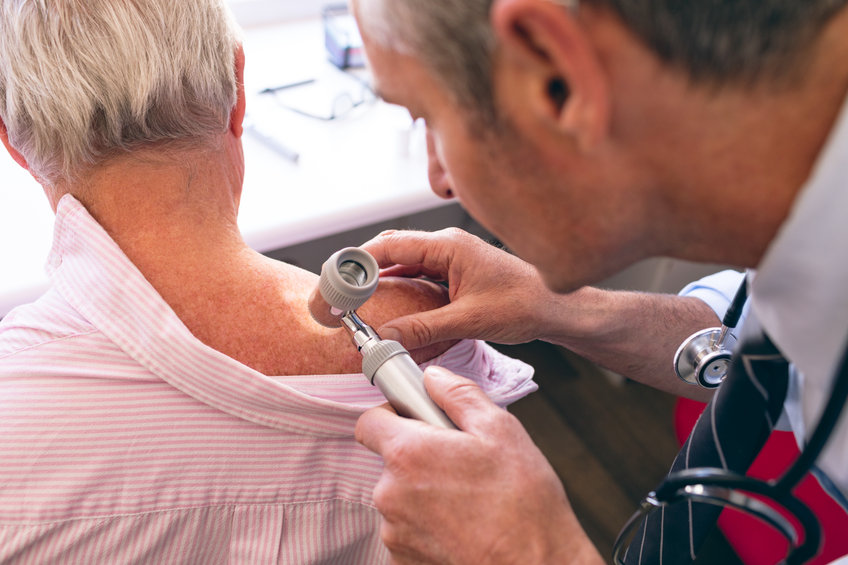Our Skin Cancer Treatment
What Exactly is Skin Cancer?
Excessive exposure to sun along with characteristics such as fair complexion can make one susceptible to skin cancer. Skin cancer is the most common form of all cancers. According to the Skin Cancer Foundation, more than 3.5 million skin cancers in over 2 million people are diagnosed annually.
Some skin cancers can be quite aggressive and challenging to treat. Because early detection is critical, dermatology patients are regularly examined to identity suspicious skin conditions. Typically they will examine the areas that are exposed to the sun including the face, hands, arms and neck. When a skin cancer has been detected, our dermatology office offers the most advanced treatment options.
Types of Skin Cancer
The three most common types of skin cancer are basal cell carcinoma (the most common and least dangerous), squamous cell carcinoma, and melanoma (the least common but most dangerous type). These names come from the name of the type of cell that becomes cancerous, a basal cell, a squamous cell, or a melanocyte.
Cancer is a very frightening word that is used to describe many very different diseases with many very different prognoses. Most cells that make up the body divide and reproduce in an orderly manner at a set slow pace. This allows the body to grow, replace worn-out tissue and repair injuries. If one of these cells is injured in some way (for example, by the sun) and becomes cancerous, it begins to replicate and divide much more quickly. With the cell dividing more rapidly, the body is unable to process all of the new cells and a mass or ball of these cells is formed. This mass of new cells is called a tumor.
In some tumors, the cells may break away from the mass, travel in the blood or lymphatic stream and set up in another part of the body and continue growing and invading the tissue. This process is called metastasizing and is associated with the more dangerous forms of cancer. This almost never occurs in basal cell carcinomas and is rare in squamous cell carcinomas that are smaller than two centimeters in width. Although not common with today’s advanced diagnostic and therapeutic methods, melanoma is most likely to metastasize and spread to other parts of the body such as the lungs, liver and bones.
Basal Cell Carcinoma
Basal cell carcinoma (BCC) is a skin cancer that arises from basal cells. Basal cells are found in the lower layers of the skin. The prognosis for patients with BCC is excellent, but if the lesion is left untreated, it can cause significant disease progression. BCC occurs primarily on the face, head, scalp, neck, and hands.Basal Cell Carcinoma can include the following characteristics:
- Waxy appearance
- Pearly appearance
- Erosion or ulceration — often in the center with pigmentation
- Bleeding — especially when traumatized
- Oozing or crusted areas — especially in large BCCs
- Rolled (raised) border
- Translucency
- Slow growing: 0.5 cm in 1-2 years
Patients with a history of skin cancer should have regular full body skin exams performed by their dermatologist, and all patients should perform monthly self examinations.
Squamous Cell Carcinoma
Squamous Cell Carcinoma is the second most common skin cancer. It arises from the superficial layers of the skin and is directly related to cumulative sun exposure. It often presents as a rough patch that bleeds, or as a rapidly growing red bump that bleeds or is tender. It may arise from an actinic keratosis. There is a positive risk of metastasis mostly in high risk patients (immunodeficient) and treatment for a squamous cell carcinoma is primarily surgical.
Malignant Melanoma
Melanoma is a skin cancer of the melanocytes which are the pigment producing cells of the skin. Melanoma is the most dangerous form of skin cancer, but if recognized and treated early it is almost always curable. The majority of melanomas are black or brown but, they can also be skin colored, pink, red or purple. Melanoma is caused mainly by intense occasional UV exposure and sunburns. The ABCDE warning signs of melanoma are growths that are:
- A — asymmetrical
- B — borders — uneven
- C — color — having a variety of color in the growth
- D — diameter — usually larger than the size of an eraser on a pencil
- E — evolving — changing in size, shape, color or elevation. Also with new symptoms such as bleeding, itching or crusting
Diagnosing Skin Cancer
A consultation is the first step towards effective skin cancer treatment. The doctor will evaluate whether the suspicious skin lesion is cancerous or benign.
An examination of the lesion will be performed. This examination will also help identify the type of skin cancer you may have and the stage of the condition. A biopsy may be ordered to determine the exact nature of the lesion.
Once your skin cancer has been diagnosed, it will be time to consider your treatment options. When deciding on the proper treatment, we will evaluate your medical records, including current medications, allergies, and past treatments.
We will create a treatment plan based on factors like the stage and type of skin cancer being addressed. The treatment plan will be discussed, along with the expected results and a cost estimate. Preparation and aftercare will also be discussed.
Feel free to ask questions during the consultation. We’re happy to help you feel as comfortable as possible when deciding on the specifics of your treatment.
Is Skin Cancer Removal Covered by Insurance?
Skin cancer removal is considered a reconstructive procedure. This means that most healthcare insurance providers cover the cost of the procedure. You will need to contact your insurance provider to get an accurate answer regarding the price of your skin cancer removal procedure.
How to Lessen the Risk of Developing Skin Cancer
There are a number of ways that you can minimize the risk of developing skin cancer in the future. The main cause of skin cancer is overexposure to ultraviolet radiation. Therefore, you can start by properly protecting your skin from sun damage.
Wear sun-protective clothing as often as possible when you are exposed to sunlight. In addition, apply water-resistant sunscreen with at least 30 SPF. You need to reapply sunscreen every two hours.
Avoid using tanning beds. You can use self-tanning products, but still apply sunscreen. Lastly, coming in for regular skin exams is very important.
Contact Us Today
If you think you may need skin cancer diagnosis and treatment in Roseville, visit Placer Dermatology. Placer Dermatology specializes in the treatment and removal of skin cancer and has a multitude of solutions to create an effective, individualized plan for you. Contact us today to schedule your consultation.


